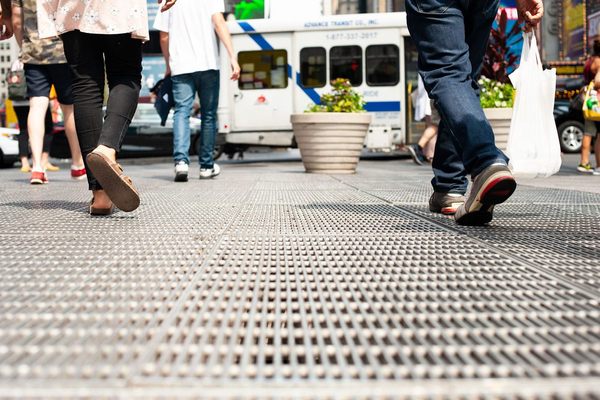
Hear the Soundscapes of Cities Transformed
“It is, in a word, quiet.”
Deep in Olympic National Park lies one of the least noise-polluted places in the United States, maybe the world. The distant drone of the Hoh River fills the valley, as the piercing song of Swainson’s thrush bounces around 800-year-old Sitka spruce trees, a cathedral-like reverberation. It is home to One Square Inch of Silence, a research project started by nature sound recordist Gordon Hempton to protect and preserve the rare ecosystem from noise pollution. I took Atlas Obscura to this magical place in 2018 for a collaboration with NPR’s All Things Considered. The Hoh Rainforest remains a special, transformative place in part because of the way it forces you to listen, really listen, to the world around. And it highlights some of what we are all experiencing today. The sonic landscape has changed. Even in the biggest, most densely populated cities, amid the uncertainty and suffering of the pandemic, people are beginning to hear something entirely new.
I am a nature sound recordist. Yes, that is a job. I seek out and record sounds that get used in movies, television, video games, and apps. I capture the sounds of factories, mines, farms, and cities around the world, but I specialize in trying to document the pristine, sans-human world. Recording the uninterrupted sounds of nature in our industrialized world is difficult, if not nearly impossible. All you have to do is look at a map of air-traffic patterns to grasp how few places in the world are truly quiet—even in Olympic National Park, a plane flies overhead every 15 to 20 minutes during peak traffic. It’s amazing how much we’ve just grown accustomed to the noise. I work to protect the few remaining “quiet” places through a nonprofit called Quiet Parks International.

Like many people around the world, my professional life has been upended by COVID-19. Each day we see news of the rising death toll, economic turmoil, and social isolation—the new constants of our lives. But there are also moments of connection and grace: people smiling and waving from across the street, check ins with neighbors we may not have spoken to before, expressions of support for healthcare workers, first responders, and other essential workers. It seems like there’s nothing that hasn’t been affected by this crisis, including the way the entire world sounds. It is, in a word, quiet.
Passenger air traffic has declined dramatically, streets are almost empty, and most people are staying home. I live just south of Yellowstone National Park, where the population density is just six people per square mile. Even in this normally quiet place, I’ve noticed an incredible change in my sonic surroundings. On a hike I took last week, I heard two planes in three hours, compared with one every 10 minutes or so under normal circumstances.
In thinking about this change of sound, I reached out via social media to some of my sound recording colleagues around the world to ask them to share with me how their soundscapes have changed. The results are truly astounding. We’ve all seen the pictures of bustling metropolises, newly empty, but the sound of them is more elusive. Large cities and their iconic points of interest are so void of people that we’re hearing them in new ways for the first time, and probably for the last time. I received more than 50 submissions from all over the world, and these are just a few of the soundscapes that stuck out to me. I hope you enjoy this unique experience—use your headphones for the greatest effect. While I’m fascinated by this new quiet that has swept the globe, I’m looking forward to the time when quiet is again hard to find. Stay safe and be well.
Covent Garden, London
Will Cohen
Usually packed with antiques and craft stalls, buzzing with people on holiday looking for something to remember from their trip, the Apple Market is at the center of this iconic shopping, food, and cultural destination. Now it is uncommonly, almost unbelievably, still.
Times Square, New York
Geoff Gersh
Times Square is always full of activity—day and night. Street performers, food vendors, tourists, locals rushing to and from work, automobile traffic. There’s always a cacophonous drone emanating from the epicenter of New York City. The lack of those sounds brings to the forefront the many mechanical sounds generated by the buildings in the area.
Grand Central Station, New York
Geoff Gersh
Grand Central rarely is not buzzing. As a major transportation hub in New York City, there is always the sound of commuters arriving or waiting for departing trains, announcements, people transferring from one train line to another, tourists gawking at the grandness of the station, and shoppers wandering through. Now all that’s left is an echoing din and announcements reminding us to cover our mouths and keep our distance from others.
Near Subhash Chandra Bose Airport, Kolkata
Dibakar Saha
This ambient sound was recorded from my home near the Kolkata International Airport, in the Indian state of West Bengal. Generally there is a lot air traffic, but now that is gone, along with the traffic and sounds of concentrated human activity—even at 4 p.m.
LAX Airport, Los Angeles
Gerardo González
This recording was taken at LAX airport during morning rush hour. Cars passed by strangely fast, construction crews continued to work, and the few remaining TSA agents were busy with their phones. For the hour I was there recording, nobody asked me to move my car. The vibe was creepy. There was almost no one else there, save a single traveler with a roller bag and someone collecting bottles and cans.
You can join the conversation about this and other stories in the Atlas Obscura Community Forums.














Follow us on Twitter to get the latest on the world's hidden wonders.
Like us on Facebook to get the latest on the world's hidden wonders.
Follow us on Twitter Like us on Facebook